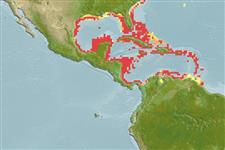>
Tetraodontiformes (Puffers and filefishes) >
Tetraodontidae (Puffers) > Canthigasterinae
Etymology: Canthigaster: Greek, kanthos = the outer or inner corner of the eye, where the lids meet, 1646 + Greek, gaster = stomach (Ref. 45335).
More on author: Bloch.
Environment: milieu / climate zone / depth range / distribution range
Écologie
marin récifal; profondeur 1 - 40 m (Ref. 43205). Tropical; 34°N - 8°N, 98°W - 59°W
Western Central Atlantic: South Carolina, USA and Bermuda to Tobago and the Lesser Antilles. All Canthigaster specimens so far recorded from Madeira belong to Canthigaster capistrata (Ref. 43205).
Taille / Poids / Âge
Maturity: Lm ? range ? - ? cm
Max length : 12.0 cm TL mâle / non sexé; (Ref. 26340)
Épines dorsales (Total): 0; Rayons mous dorsaux (Total): 10-11; Épines anales 0; Rayons mous anaux: 9. Distinguished from all other Atlantic species by a short upper dark longitudinal stripe, presence of few spots on flank and dorsum, and absence of a conspicuous (larger than eye) spot on the dorsum. The upper dark longitudinal stripe extends from caudal-fin dorsal margin to the vertical through dorsal-fin base. Although a horizontal line of dark spots extends anterior to the anterior portion of the horizontal dark stripe in some specimens, and sometimes even surpasses the dorsal fin base, this line of spots never forms a continuous stripe. Also distinguished by the absence of vertically oriented bars on the caudal fin and by the presence of bars on the snout (Ref. 43205).
Inhabits reefs and marginal habitats such as seagrass beds (Ref. 43205). Diet consists of seagrass, sponges, crabs and other crustaceans, mollusks, polychaete worms, sea urchins, starfishes, hydroids and algae (Ref. 13442). Monogamous (Ref. 52884).
Life cycle and mating behavior
Maturité | Reproduction | Frai | Œufs | Fécondité | Larves
Oviparous (Ref. 205). No parental care according to Ref. 38836.
Moura, R.L. and R.M.C. Castro, 2002. Revision of Atlantic sharpnose pufferfishes (Tetraodontiformes: Tetraodontidae: Canthigaster), with description of three new species. Proc. Biol. Soc. Wash. 115(1):32-50. (Ref. 43205)
Statut dans la liste rouge de l'IUCN (Ref. 130435)
Menace pour l'homme
Harmless
Utilisations par l'homme
Aquarium: Commercial
Plus d'informations
RéférencesAquacultureProfil d'aquacultureSouchesGénétiqueElectrophoresesHéritabilitéPathologiesTraitementNutrientsMass conversion
Outils
Articles particuliers
Télécharger en XML
Sources Internet
Estimates based on models
Preferred temperature (Ref.
123201): 23.6 - 28, mean 26.4 °C (based on 220 cells).
Phylogenetic diversity index (Ref.
82804): PD
50 = 0.5000 [Uniqueness, from 0.5 = low to 2.0 = high].
Bayesian length-weight: a=0.03631 (0.01554 - 0.08482), b=2.88 (2.69 - 3.07), in cm total length, based on LWR estimates for this Genus-body shape (Ref.
93245).
Niveau trophique (Ref.
69278): 3.3 ±0.1 se; based on diet studies.
Résilience (Ref.
120179): Haut, temps minimum de doublement de population inférieur à 15 mois (Preliminary K or Fecundity.).
Fishing Vulnerability (Ref.
59153): Low vulnerability (10 of 100).
Nutrients (Ref.
124155): Calcium = 102 [47, 253] mg/100g; Iron = 0.966 [0.474, 2.280] mg/100g; Protein = 18.2 [16.0, 20.4] %; Omega3 = 0.133 [0.065, 0.262] g/100g; Selenium = 35.1 [17.1, 79.4] μg/100g; VitaminA = 52.6 [14.7, 200.9] μg/100g; Zinc = 1.59 [1.01, 2.41] mg/100g (wet weight);
